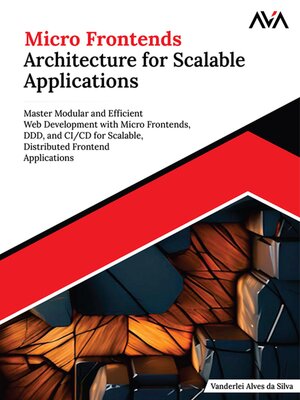Micro Frontends Architecture for Scalable Applications
ebook ∣ Master Modular and Efficient Web Development with Micro Frontends, DDD, and CI/CD for Scalable, Distributed Frontend Applications (English Edition)
By Vanderlei Alves da Silva

Sign up to save your library
With an OverDrive account, you can save your favorite libraries for at-a-glance information about availability. Find out more about OverDrive accounts.
Find this title in Libby, the library reading app by OverDrive.



Search for a digital library with this title
Title found at these libraries:
| Library Name | Distance |
|---|---|
| Loading... |
Unleash Agility and Scale with Micro Frontend Architecture.Key Features● Gain a solid understanding of micro frontend principles, patterns, and benefits.● Explore integration strategies with real-world examples and practical guidance.● Discover best practices for adoption, testing, deployment, and long-term scalability.Book DescriptionAs modern web applications grow in complexity, micro frontend architecture offers a scalable, modular approach that helps teams work independently, accelerate delivery, and maintain long-term flexibility. Micro Frontends Architecture for Scalable Applications provides a comprehensive, hands-on guide to implementing micro frontends effectively in real-world projects.The book starts by defining frontend and backend development, exploring what is considered a valuable architecture, and introducing various frontend architecture patterns.Next, it dives into micro frontends and concepts like Domain-Driven Design, Decentralized Governance, and Independent Deployments. It explains how these principles enable highly observable (easy-to-monitor) micro frontends and covers in-depth discussions on integration strategies, their advantages and disadvantages.Communication and routing are thoroughly explored, including Container Applications, State Management, and Cross-Application Communication. The book also addresses UI/UX considerations and how micro frontends interact with varying backend patterns.The final part focuses on best practices for testing (unit, integration, and end-to-end), deployment strategies, and essential security measures. It concludes with a real-world case study and insights into the future of micro frontends—highlighting emerging trends, evolving architectures, and the growing impact of artificial intelligence.What you will learn● Design scalable frontend architectures using modular principles.● Choose and apply the right integration strategy per use case.● Build CI/CD pipelines optimized for micro frontend deployments.● Handle routing, shared state, and communication across applications.● Ensure UI/UX consistency with design systems in distributed teams.● Explore how AI and emerging trends impact frontend architectures.Table of Contents1. A Tale of Two Worlds2. Valuable Architecture3. Frontend Architectural Patterns4. Micro Frontend Foundations5. Integration Strategies6. Communication and Routing7. UI/UX and Design System8. Backend Patterns9. Testing Strategies10. Deployment Strategies11. Observability12. A Micro Frontend Adoption IndexAbout the AuthorsVanderlei Alves da Silva is a seasoned Frontend Architect with over 15 years of experience in designing and building distributed systems and cloud-native applications. His career is driven by a deep passion for system architecture and frontend development, helping industry-leading organizations to craft scalable, resilient, and user-focused software.What drives Vanderlei is the belief that a well-crafted software has the power to solve real human problems — whether it is helping someone's grandmother find what she is looking for on a webpage or solving complex organizational challenges at scale. For him, writing a code is more than just engineering; it is a form of storytelling — every function, every interface, and every design choice contributes to the evolving story of a system.







